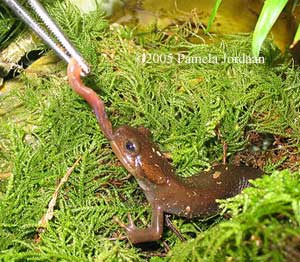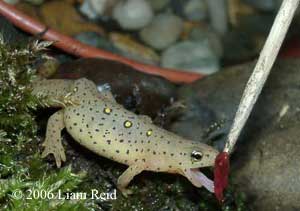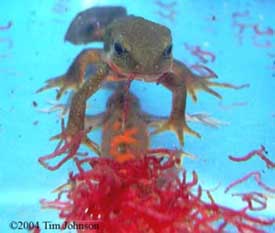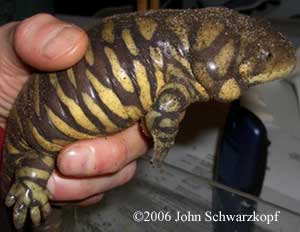CC FAQ Pages
Other Resources
General Care and Feeding FAQ
Are newts or salamanders easy pets? Are they good pets for children?
They CAN be easy pets if you get healthy ones, keep them cool enough, and feed the right foods. Maintaining a healthy newt or salamander takes little work other than some cleaning and feeding. BUT realize that cooling your newt down to the temperature he needs may be very expensive.
The most widely available newt species,
Cynops orientalis, is very sensitive to warm temperatures and often arrives to pet stores in poor condition. Here are some species that are more hardy:
Pleurodeles waltl, Tylototriton verrucosus, Cynops pyrrhogaster, and Cynops ensicauda. These four species can tolerate temps above 21°C (72°F) as long as they are healthy. None of these species is readily available in a pet shop, except occasionally C. pyrrhogaster. To obtain the others you need to find a breeder.
Most children like pets they can interact with. Newts and salamanders are not that type of pet. Handling and playing with them will cause them a lot of stress, which could kill them. Instead they should be left alone and observed, much like fish. In addition, newts and salamanders are poisonous. If this doesn't sound like something your child would enjoy, look into easily handled pets like leopard geckos or corn snakes. Both of these animals make excellent first pets.
I want a newt/salamander. What kind should I get, and how should I pick it out?
The most commonly-available newt is the Chinese firebelly (Cynops orientalis). This is unfortunate because these newts are fairly fragile compared to some others, and they often arrive at pet stores in poor condition. Most newts and salamanders are fairly hardy, given cool temperatures, clean habitat, and good food.
The most commonly-available salamanders are tiger salamanders (Ambystoma mavortium) and fire salamanders (Salamandra salamandra). Both are fairly hardy, but keeping them too warm or in the wrong habitat can result in sickness or death.
Before you bring home a newt or salamander, get its home ready. Research the species to decide on the best setup. When choosing a newt at a pet shop, pick the largest and healthiest looking. If it's an aquatic species (such as a firebelly newt), try to get one that is staying in the water, not on land.
NOTE: All newts and salamanders sold by pet stores and most sold by online sources are WILD-CAUGHT. Considering the decline of amphibians in the wild, think about whether you want to want to contribute to the collection of wild amphibians as pets. To obtain a captive-bred caudate, you need to obtain it directly from a breeder, and these animals are likely to be juveniles, not adults.

Where can I find a caresheet for ____________?
For a complete list of available caresheets, see our Caresheets page. If the caresheet you need is not available, read the sheets for related species. Then read journals, books, and field guides to get a good idea. You may also want to visit the Caudata.org chat room or the Caudata.org forum.
Why isn't my animal eating?
This is a common problem with new animals. They are just getting use to a new place and are under too much stress to hunt down prey. Keep them dark and leave them alone so they can get used to their new surroundings. If you have neglected to do the research on caring for your animal before now, do it right away. You may be feeding it the wrong thing or housing it the wrong way. Both these can also lead to not eating. Above all, try LIVE FOODS. It may be necessary to hand-feed with a tweezers or a toothpick.
What should I feed my animal?
Caudates are carnivores that feed primarily on invertebrates (worms, insects, and crustaceans). Live food is usually preferred over frozen, and frozen preferred over dry. What you actually feed depends on the species. Pellets are less palatable than other foods, and many newts/sals refuse to eat them.

Excellent foods for newts and salamanders include live earthworms from a pesticide-free yard, nightcrawlers from a bait shop (chopped if necessary), live blackworms/bloodworms (sold at pet stores), frozen bloodworms, live crickets, live waxworms, live slugs, spiders and bugs from outdoors. For more information on foods, see Food for Captive Caudates and Worms, the Ideal Food for Caudates.
How often should I feed?
It depends. If you have a healthy, well-established newt/salamander, and it is kept at a cool temperature, you can feed it about every third day. But this varies depending on your animal's age and metabolism. Amphibians use more energy in warmer weather, and may need more feedings in summer, less in winter. If your newt/salamander is a juvenile or is skinny, it needs to be fed daily. If your newt has just been purchased from a pet shop, it is likely to be underfed and should be fed daily until well-established.
How much should I feed?

Like fish, the general rule is to feed as much as the animal(s) will eat in one sitting. To some extent, this just has to be learned by trial-and-error. If the animal appears obese, feed less. However, obesity is rarely a problem for newts and salamanders. Avoid leaving uneaten crickets or other live feeders that can bite or irritate the animal. In an aquatic setup, always remove uneaten food within a few hours of feeding to avoid fouling the water.
How long can a newt/salamander survive without eating?
A long time. Animals that are bought at a pet store may already be starved for several weeks. They may continue to 'look OK' for several more weeks. Starved animals should be enticed to eat with live foods offered in small quantities. Feeding a starved animal too much too quickly can result in 'refeeding syndrome', which can be fatal.
Can my newt eat feeder fish?
Very few species of newts and salamanders actually eat fish in the wild. Many newts and sals are too slow-moving to catch them. Instead, newts should primarily be fed on a variety of invertebrates, such as worms and insects. Based on anecdotal evidence, feeder fish are probably not the healthiest food source for newts in captivity. Also, feeder fish often carry diseases, and these diseases may pose a risk to your newt. If you use feeder fish, breed your own to avoid disease risk.

Will my newt/salamander become obese if I overfeed it?
Most newts and salamanders will stop eating when full, and will not accept food beyond what they need to maintain normal fat stores. Some species, such as Tylototritons (crocodile newts) being plump is normal and probably healthy. However, a few species are prone to obesity, including Salamandra (fire salamanders), and Ambystoma (tiger salamanders, axolotls, and kin). Certain types of food are associated with obesity, including pinky mice and other types of mammalian meat. The overweight tiger salamander shown was fed pinky mice. High fat invertebrates, such as waxworms, should also not be fed too often.

